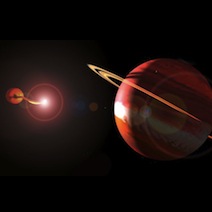Astronomers have observed an anomaly in the eclipses of a binary star system. They suggest this could be due to the presence of two giant planets, orbiting the stellar binary.
The two stars, known as UZ For, are both smaller than our Sun. One of them is a white dwarf, the other a red dwarf. They are so close to each other that it takes only a bit more than two hours to complete a revolution. In fact, the whole stellar binary would fit in our Sun!
Because they are aligned with Earth, when the stars pass in front of one another, they produce eclipses, which allow astronomers to determine their properties very accurately. When observing these eclipses with the Southern African Large Telescope (SALT), researchers noticed that they don’t occur regularly. Instead, some of the eclipses occur too early, others too late (they also used archival data from multiple observatories and satellites). To explain the phenomenon, the scientists suggest that two giant planets could cause the orbits of the stars to wobble because of their strong gravitational pull.
For this model to work, they estimate the two planets should be at least 6.3 and 7.7 times more massive than Jupiter. The planets would complete one orbit each 5.25 and 16 years. The system, located in constellation Fornax, is unfortunately too far for the planets to be directly imaged.
Because of their proximity, the more massive star is constantly accreting matter from its smaller companion, emitting enormous amounts of X-rays. This very inhospitable environment, because of the nature of the two stars composing the binary, would be quite a weird new planetary system if the existence of these planets is confirmed.

